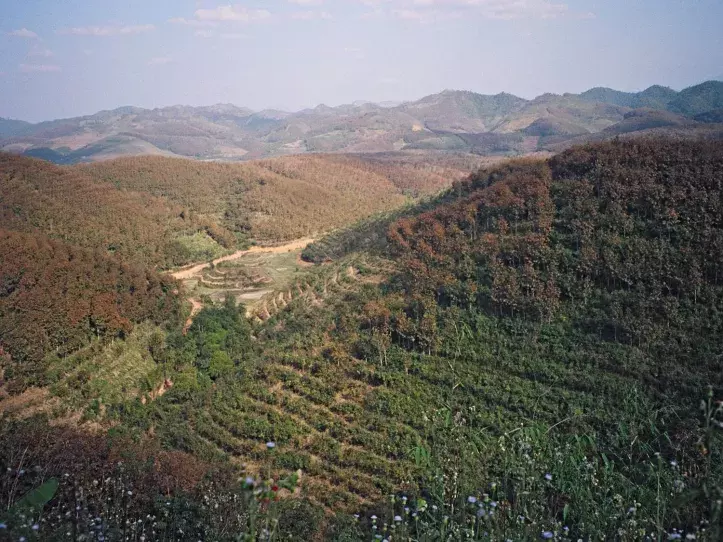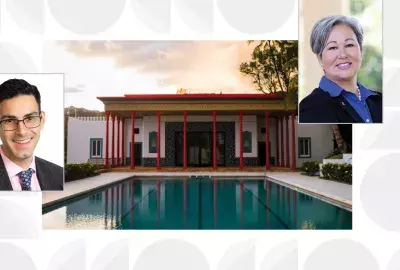Error message

By Kaspar Hurni and Jefferson Fox
HONOLULU (Sept. 19, 2018)—Over the past 50 years, the mountainous region of mainland Southeast Asia has witnessed a dramatic expansion of commercialized agriculture. The emphasis has been on tree-based cash crops and, in particular, on rubber. Much of this expansion has come at the expense of the region’s native forests.
A study of time-series data derived from satellite images tracked land use and land-use change in Southeast Asia from 2003 to 2014. The study focused on an area more than twice the size of France where land-use change has been most dramatic—all of Cambodia and Laos, most of Vietnam, northeast Thailand, Shan State in Myanmar, and Xishuangbanna Prefecture in southern Yunnan, China.
During the 11-year study period, the area planted with rubber more than quadrupled (see table), so that by 2014, rubber accounted for 8 percent of total land cover in the region. Seventy percent of this expansion came at the expense of natural forests, while 30 percent of the new rubber trees replaced other types of land use, mainly agricultural crops.
Deforestation was greatest in Cambodia and Laos, but there was also significant forest loss in Vietnam, Xishuangbanna Prefecture, and Shan State. Such a massive transition from natural forests to agricultural crops—even tree crops—has disturbing consequences for the environment.
What is governing the pattern and pace of rubber expansion? The primary drivers are government policies and fluctuations in world rubber prices. Starting in the early 2000s, policies in Cambodia, Laos, and Myanmar paved the way for land concessions that allowed companies to grow rubber at very large scales. By contrast, government policies in Thailand and China supported the development of rubber production by small-scale local farmers. In Vietnam, government policies provided some support to small farmers but also encouraged the development of large plantations.
During this period, rubber prices rose steadily until the economic crisis of 2008 and then fell steeply. Prices recovered and continued to rise until the European debt crisis of 2011, when they fell again. Prices deteriorated until about 2014 and since then have essentially remained stagnant. Although rubber expansion generally followed price fluctuations, the pattern has been different in each country, largely due to differences in government policies.

In Cambodia, 28,739 km2 were converted to rubber between 2003 and 2014. Virtually all (98 percent) of these new rubber plantations replaced natural forests. Most were established by companies on large government land concessions, but in 2012, the Cambodian government placed a moratorium on new concessions. Companies that had already received land continued to plant rubber trees in spite of unfavorable prices because the law required that all concession land be utilized. Recent interviews indicate that companies holding these concessions are diversifying into cashews and black pepper.
In Laos, 7,291 km2 were converted to rubber between 2003 and 2014. As in Cambodia, virtually all (97 percent) of these new rubber plantations replaced natural forests. Up to 2007, a land-titling program granted land concessions to companies from neighboring countries, most often Vietnam or China. The Chinese companies also received subsidies through the Chinese government’s Opium Replacement Program. Then in 2007 and again in 2012, the Lao government placed a moratorium on new land concessions. Rubber expansion essentially stopped after the 2011 financial crisis.
In Myanmar’s Shan State, 2,866 km2 were converted to rubber between 2003 and 2014, mostly during the early years of the study period. Ninety percent of these new rubber plantations replaced natural forests. In 2012, the government passed several laws to facilitate the development of largescale land concessions. Most concessions were granted in upland areas along the Thai and Chinese borders, taking land away from customary farmers whose tenure rights were not recognized. The Chinese government’s Opium Replacement Program supported much of this activity. Despite favorable laws and Chinese support, rubber planting essentially stopped after the 2008 financial crisis, although there has been a slight uptick since 2012.
Beginning with a campaign in 2002, the Chinese government provided subsidies and extension services to small farmers in Xishuangbanna Prefecture who wished to plant rubber. Between 2003 and 2014, 3,868 km2 were converted to rubber. Eighty-five percent of the new rubber plots replaced natural forests where farmers had practiced shifting cultivation. Most were planted during the first part of the study period―very little rubber has been planted since the 2008 financial crisis.
In northeast Thailand, many small farmers have converted existing cropland to rubber plantations. Between 2003 and 2014, 18,915 km2 were converted to rubber. Only 4 percent of these new rubber plantations replaced natural forests, largely because the region had already been heavily deforested. After the 2008 financial crisis, farmers in northeast Thailand stopped planting rubber, and many began planting fruit trees.
In Vietnam, 13,282 km2 were converted to rubber between 2003 and 2014. Seventy-one percent of these new plantations replaced natural forests. In 2009, the government issued a policy aimed at encouraging rubber production, but as in other countries, expansion dropped after the financial crisis of 2011.
This analysis shows that the expansion of rubber created significant deforestation in all the countries of the region except Thailand, where rubber was planted on land that had already been deforested. The expansion of rubber has slowed in recent years with the fall of international prices, but this does not necessarily mean that land cleared for plantations will revert to natural forests.
As farmers replace rubber, there has been a boom in bananas in northern Laos and reports of farmers planting cashews and black pepper in northeast Cambodia. In Thailand, some forests are beginning to regrow on former cropland. In Vietnam, large government-supported afforestation programs are contributing to expansion of secondary forests, although primary forests are still being lost at high rates.
This study has provided more detailed and accurate information on land-use change in Southeast Asia than was available in the past. The pace of change may have slowed, but it is unlikely that significant areas of the region will be allowed to revert to natural forests. Today, site-specific assessments are needed to better understand the impacts of the changes that have been documented and to design approaches to minimize environmental damage.
Kaspar Hurni is a Post-Doctoral Fellow with the Center for Development and Environment at the University of Bern, Switzerland. He can be reached at [email protected]. Jefferson Fox is Director of the Research Program at the East-West Center. He can be reached at [email protected].
This East-West Wire is based on Kaspar Hurni and Jefferson Fox (2018), The expansion of tree-based boom crops in mainland Southeast Asia: 2001 to 2014, Journal of Land Use Science.
Download a PDF version of this Wire article.
##
The East-West Wire is a news, commentary, and analysis service provided by the East-West Center in Honolulu. All or any part of the Wire content may be used by media with attribution to the East-West Center or the person quoted. To receive Wire articles via email, subscribe here. For links to all East-West Center media programs, fellowships and services, see www.eastwestcenter.org/journalists.
The full list of East-West Wires produced by the Research Program is available on the East-West Center website. For more on the East-West Center Research Program, see www.eastwestcenter.org/research.
The East-West Center promotes better relations and understanding among the people and nations of the United States, Asia, and the Pacific through cooperative study, research, and dialogue.
Series editors:
Derek Ferrar
[email protected]
Sidney B. Westley
[email protected]
By Kaspar Hurni and Jefferson Fox
HONOLULU (Sept. 19, 2018)—Over the past 50 years, the mountainous region of mainland Southeast Asia has witnessed a dramatic expansion of commercialized agriculture. The emphasis has been on tree-based cash crops and, in particular, on rubber. Much of this expansion has come at the expense of the region’s native forests.
A study of time-series data derived from satellite images tracked land use and land-use change in Southeast Asia from 2003 to 2014. The study focused on an area more than twice the size of France where land-use change has been most dramatic—all of Cambodia and Laos, most of Vietnam, northeast Thailand, Shan State in Myanmar, and Xishuangbanna Prefecture in southern Yunnan, China.
During the 11-year study period, the area planted with rubber more than quadrupled (see table), so that by 2014, rubber accounted for 8 percent of total land cover in the region. Seventy percent of this expansion came at the expense of natural forests, while 30 percent of the new rubber trees replaced other types of land use, mainly agricultural crops.
Deforestation was greatest in Cambodia and Laos, but there was also significant forest loss in Vietnam, Xishuangbanna Prefecture, and Shan State. Such a massive transition from natural forests to agricultural crops—even tree crops—has disturbing consequences for the environment.
What is governing the pattern and pace of rubber expansion? The primary drivers are government policies and fluctuations in world rubber prices. Starting in the early 2000s, policies in Cambodia, Laos, and Myanmar paved the way for land concessions that allowed companies to grow rubber at very large scales. By contrast, government policies in Thailand and China supported the development of rubber production by small-scale local farmers. In Vietnam, government policies provided some support to small farmers but also encouraged the development of large plantations.
During this period, rubber prices rose steadily until the economic crisis of 2008 and then fell steeply. Prices recovered and continued to rise until the European debt crisis of 2011, when they fell again. Prices deteriorated until about 2014 and since then have essentially remained stagnant. Although rubber expansion generally followed price fluctuations, the pattern has been different in each country, largely due to differences in government policies.

In Cambodia, 28,739 km2 were converted to rubber between 2003 and 2014. Virtually all (98 percent) of these new rubber plantations replaced natural forests. Most were established by companies on large government land concessions, but in 2012, the Cambodian government placed a moratorium on new concessions. Companies that had already received land continued to plant rubber trees in spite of unfavorable prices because the law required that all concession land be utilized. Recent interviews indicate that companies holding these concessions are diversifying into cashews and black pepper.
In Laos, 7,291 km2 were converted to rubber between 2003 and 2014. As in Cambodia, virtually all (97 percent) of these new rubber plantations replaced natural forests. Up to 2007, a land-titling program granted land concessions to companies from neighboring countries, most often Vietnam or China. The Chinese companies also received subsidies through the Chinese government’s Opium Replacement Program. Then in 2007 and again in 2012, the Lao government placed a moratorium on new land concessions. Rubber expansion essentially stopped after the 2011 financial crisis.
In Myanmar’s Shan State, 2,866 km2 were converted to rubber between 2003 and 2014, mostly during the early years of the study period. Ninety percent of these new rubber plantations replaced natural forests. In 2012, the government passed several laws to facilitate the development of largescale land concessions. Most concessions were granted in upland areas along the Thai and Chinese borders, taking land away from customary farmers whose tenure rights were not recognized. The Chinese government’s Opium Replacement Program supported much of this activity. Despite favorable laws and Chinese support, rubber planting essentially stopped after the 2008 financial crisis, although there has been a slight uptick since 2012.
Beginning with a campaign in 2002, the Chinese government provided subsidies and extension services to small farmers in Xishuangbanna Prefecture who wished to plant rubber. Between 2003 and 2014, 3,868 km2 were converted to rubber. Eighty-five percent of the new rubber plots replaced natural forests where farmers had practiced shifting cultivation. Most were planted during the first part of the study period―very little rubber has been planted since the 2008 financial crisis.
In northeast Thailand, many small farmers have converted existing cropland to rubber plantations. Between 2003 and 2014, 18,915 km2 were converted to rubber. Only 4 percent of these new rubber plantations replaced natural forests, largely because the region had already been heavily deforested. After the 2008 financial crisis, farmers in northeast Thailand stopped planting rubber, and many began planting fruit trees.
In Vietnam, 13,282 km2 were converted to rubber between 2003 and 2014. Seventy-one percent of these new plantations replaced natural forests. In 2009, the government issued a policy aimed at encouraging rubber production, but as in other countries, expansion dropped after the financial crisis of 2011.
This analysis shows that the expansion of rubber created significant deforestation in all the countries of the region except Thailand, where rubber was planted on land that had already been deforested. The expansion of rubber has slowed in recent years with the fall of international prices, but this does not necessarily mean that land cleared for plantations will revert to natural forests.
As farmers replace rubber, there has been a boom in bananas in northern Laos and reports of farmers planting cashews and black pepper in northeast Cambodia. In Thailand, some forests are beginning to regrow on former cropland. In Vietnam, large government-supported afforestation programs are contributing to expansion of secondary forests, although primary forests are still being lost at high rates.
This study has provided more detailed and accurate information on land-use change in Southeast Asia than was available in the past. The pace of change may have slowed, but it is unlikely that significant areas of the region will be allowed to revert to natural forests. Today, site-specific assessments are needed to better understand the impacts of the changes that have been documented and to design approaches to minimize environmental damage.
Kaspar Hurni is a Post-Doctoral Fellow with the Center for Development and Environment at the University of Bern, Switzerland. He can be reached at [email protected]. Jefferson Fox is Director of the Research Program at the East-West Center. He can be reached at [email protected].
This East-West Wire is based on Kaspar Hurni and Jefferson Fox (2018), The expansion of tree-based boom crops in mainland Southeast Asia: 2001 to 2014, Journal of Land Use Science.
Download a PDF version of this Wire article.
##
The East-West Wire is a news, commentary, and analysis service provided by the East-West Center in Honolulu. All or any part of the Wire content may be used by media with attribution to the East-West Center or the person quoted. To receive Wire articles via email, subscribe here. For links to all East-West Center media programs, fellowships and services, see www.eastwestcenter.org/journalists.
The full list of East-West Wires produced by the Research Program is available on the East-West Center website. For more on the East-West Center Research Program, see www.eastwestcenter.org/research.
The East-West Center promotes better relations and understanding among the people and nations of the United States, Asia, and the Pacific through cooperative study, research, and dialogue.
Series editors:
Derek Ferrar
[email protected]
Sidney B. Westley
[email protected]
East-West Wire
News, Commentary, and Analysis
The East-West Wire is a news, commentary, and analysis service provided by the East-West Center in Honolulu. Any part or all of the Wire content may be used by media with attribution to the East-West Center or the person quoted. To receive East-West Center Wire media releases via email, subscribe here.
For links to all East-West Center media programs, fellowships and services, see www.eastwestcenter.org/journalists.







